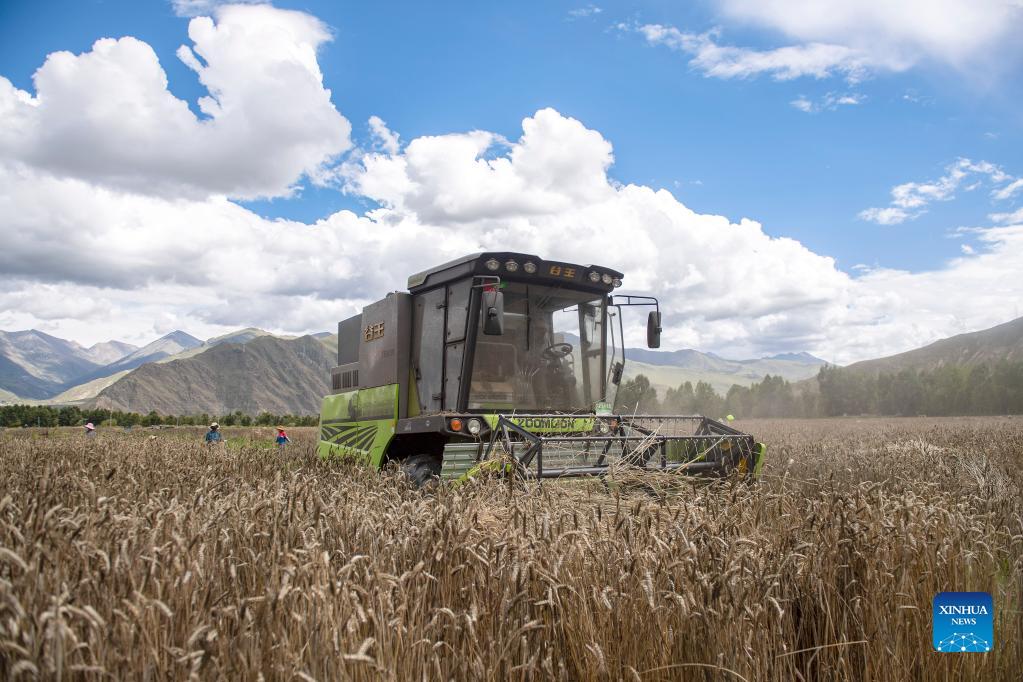China to celebrate farmer’s festival with a bumper harvest
The Chinese Farmers' Harvest Festival, a national festival held specifically for the country’s farmers, falls on Sept. 23 this year during the country’s agricultural harvest season. The festival has been celebrated since 2018, becoming a symbol of China’s farming culture.

A farmer operates a harvester to reap highland barley at Kere Village of Dagze District, Lhasa, capital of southwest China's Tibet Autonomous Region, Sept. 6, 2021. (Xinhua/Sun Ruibo)
The year 2021 marks the first year when China will start to implement a system under which the Party and government departments share equal responsibilities for the country’s food security. Various localities across the country have been taking vigorous efforts to reclaim abandoned land and increase grain planting areas, expanding the planting areas for early-season rice and autumn grains, with the planting areas for high-yield corn growing substantially. This has laid a solid foundation for a bumper harvest throughout the year.
“The costs related to rice growing increased during the spring ploughing season. Then the government came to our help by issuing favorable policies, raising the purchasing prices for rice, and granting allowances to us for rice growing and pest control. I’m sure that I’ll embrace a bumper harvest with my 400 mu (26.67 hectares) of rice fields,” said a farmer named Li Chunfeng who is based in Shanghai.
Jilin province in northeast China is a major rice production base in the country. This year, the rice planting area in the province has surpassed 12.5 million mu, with the total autumn-season grain cultivation area in the country being more than 1.29 billion mu. Currently, the area cultivated for autumn grains is experiencing normal growth, laying a solid foundation for a bumper fall harvest.
“Due to the unfriendly weather, this year we started transplanting rice seedlings at a later date. Thankfully, the government offered us assistance by guaranteeing labor and material supplies, which allowed us to finish rice transplanting on time,” said Liu Wangcheng, head of a ranch based in Da’an city, Jilin.
To promote the cultivation of rice using double-cropping methods, Lujiang county in east China’s Anhui province provides subsidies of 20 percent more than average to farmers planting double-crop rice than to those growing single-crop rice, and grants another 100 yuan per mu of land planted with early-season rice to farmers who cultivate more than 50 mu of double-crop rice. “I planted 150 mu of double-crop rice this year. With a yield of more than 500 kilograms per mu and a price of 2.58 yuan for per kg of rice, the rice crops are projected to generate considerable incomes for me,” said Wang Shizhao, a major rice grower in Lujiang.
In the first quarter of this year, the central government and local governments earmarked 3 billion yuan in funds for pest and disease control for wheat and carried out pest and disease control programs for more than 1 billion mu of wheat, keeping the yield losses caused by pests and diseases within 5 percent. When the prices of chemical fertilizers and pesticides were notably driven up in April, the central government earmarked 20 billion yuan in funds for granting one-off subsidies to crop-growing farmers in light of the extra costs arising from the farming supplies needed for major grain crops, aiming to keep their incomes stable.
Various localities across the country have made headway in building a modern agriculture industry characterized by high-efficiency, safe, energy-conserving, and environmentally-friendly farming. In Wangcang county, southwest China’s Sichuan province, harvesters were seen operating in rice fields. “Now the use of machinery in rice harvesting has reached 90 percent, and it takes about one hour to harvest 1 mu of a rice field, reducing costs related to harvesting per mu of rice by more than 500 yuan,” said a rice grower named Cui Lianzhong.
During this year’s spring ploughing season, more than 30,000 plant protection drones and 20,000 tractors powered by the Beidou navigation system, along with other agricultural tools, were used for completing farming-related tasks. During the harvest season in the summer months, more than 600,000 combine harvesters were deployed to harvest wheat. At present, the mechanization rate of farming and the harvesting of wheat, rice and corn has reached 71 percent.
At a crop plantation run by a farmers’ cooperative in Gongzhuling city, Jilin, corn crops were seen growing successfully on 125 hectares of black soil. According to Su Donghong, head of the cooperative, they have been using crop straws as a natural fertilizer to thicken the top layer of black soil, one of the most fertile soils found in the world. Su further added that each year, they can cultivate black soil with a thickness of one centimeter on one hectare of land, enabling the rice yield to reach more than 1,000 kg.
At present, more than 28 million mu of black soil in Jilin, or one third of the province’s total grain planting area, has been protected based on normal growing patterns. That coverage is expected to reach 70 percent by 2025. “The total grain production in Jilin each year between 2021 and 2025 is expected to hit 40 billion kg,” according to Zhang Fengchun, head of the department of agriculture and rural affairs for Jilin province.
Photos
 Bumper harvest presents a magnificent scene of terraced rice paddies in SW China's Luzhou city
Bumper harvest presents a magnificent scene of terraced rice paddies in SW China's Luzhou city In pics: life of Siberian tigers in NE China's breeding center
In pics: life of Siberian tigers in NE China's breeding center Explore wonderland created by an alpine lake cluster in SW China's Yunnan
Explore wonderland created by an alpine lake cluster in SW China's Yunnan In pics: Museums across China unveil creative and culturally-inspired mooncakes
In pics: Museums across China unveil creative and culturally-inspired mooncakes
Related Stories
Copyright © 2021 People's Daily Online. All Rights Reserved.






